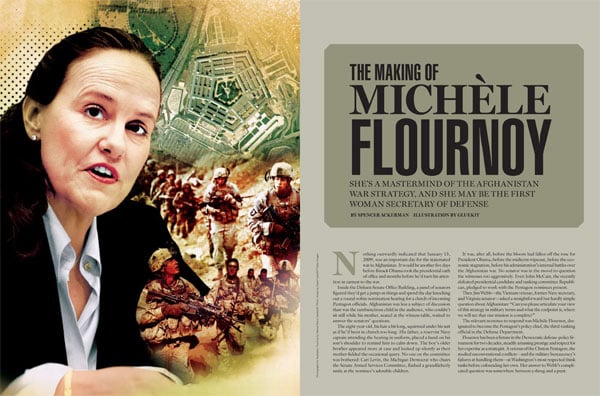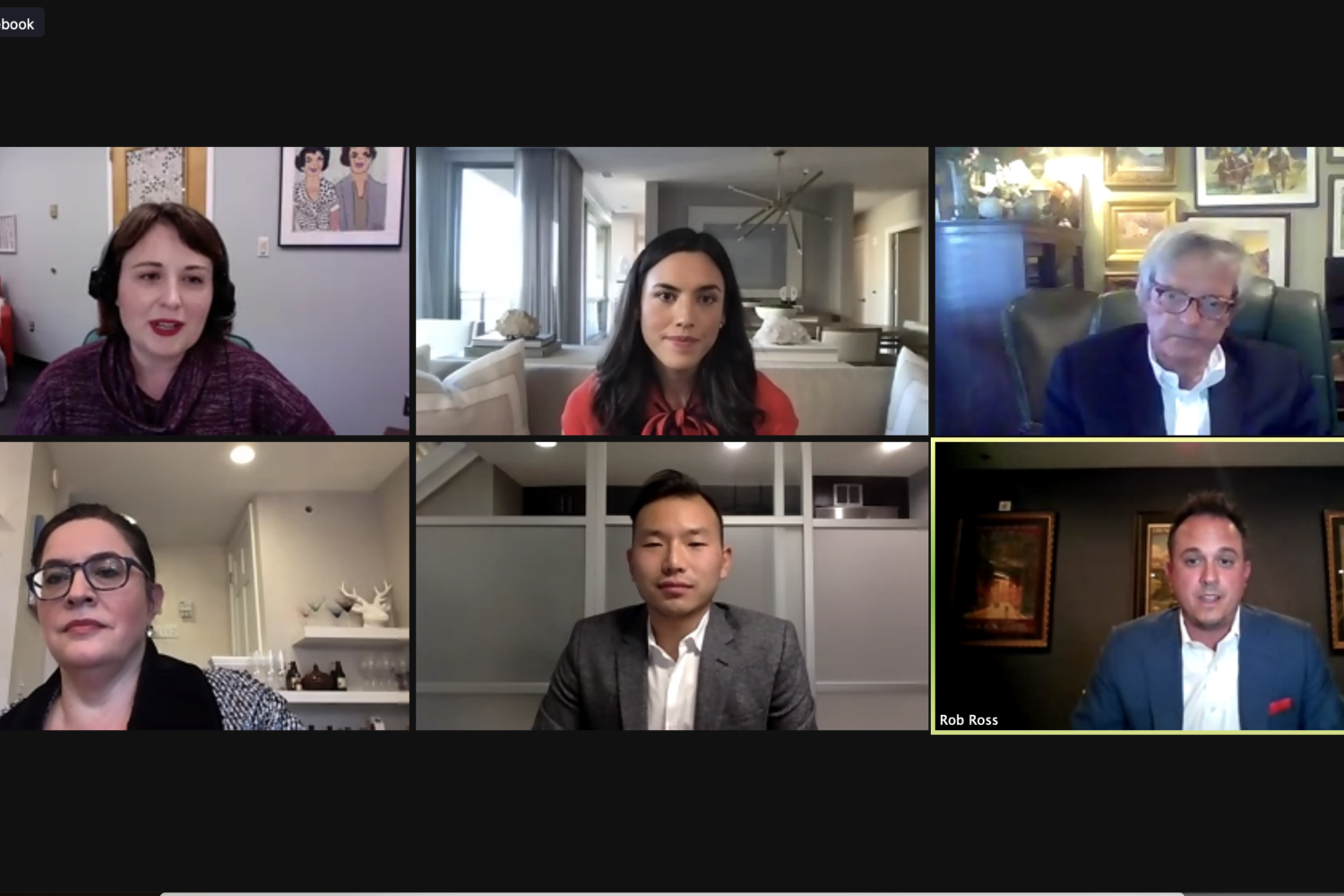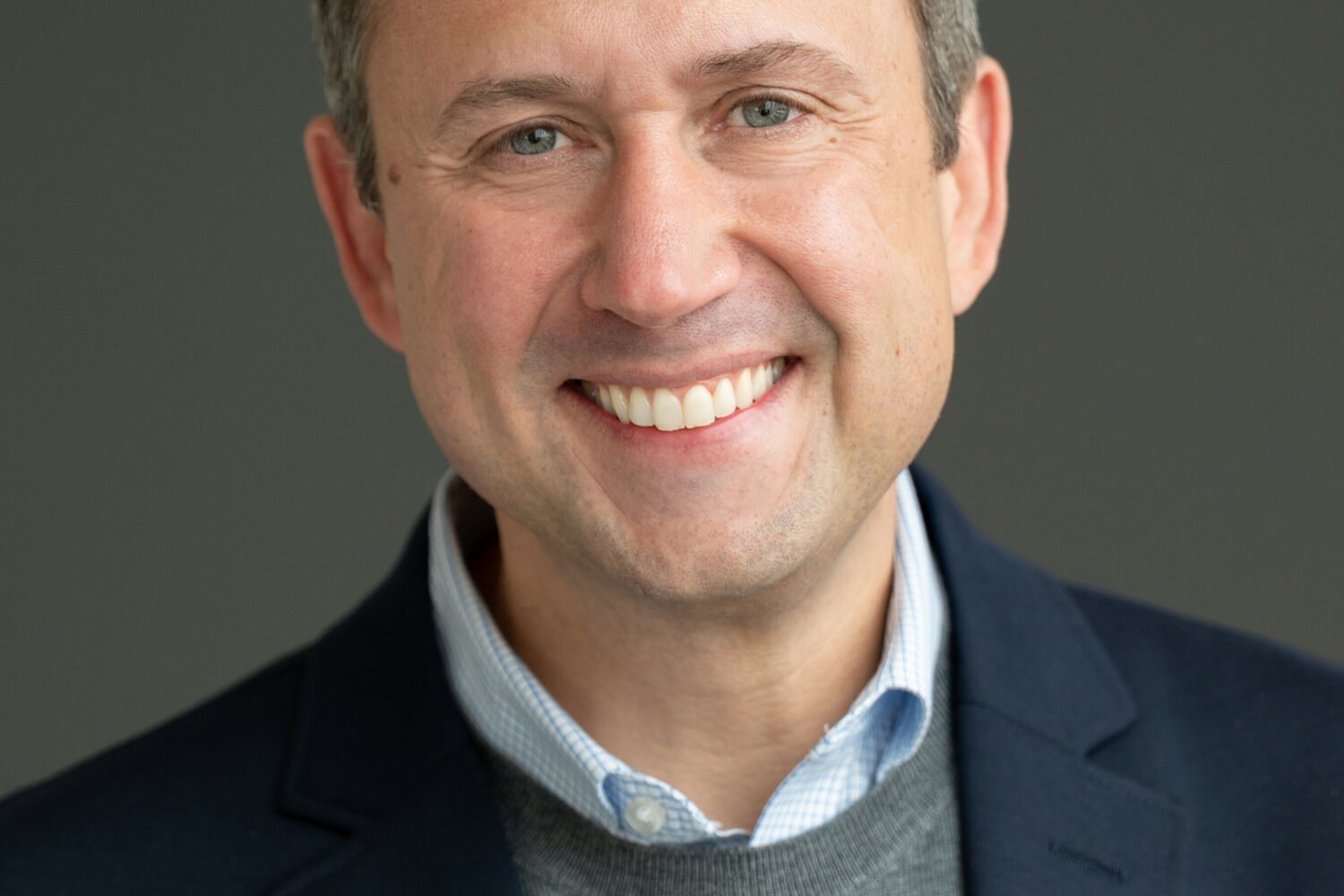Nothing outwardly indicated that January 15, 2009, was an important day for the stalemated war in Afghanistan. It would be another five days before Barack Obama took the presidential oath of office and months before he’d turn his attention in earnest to the war.
Inside the Dirksen Senate Office Building, a panel of senators figured they’d get a jump on things and spend the day knocking out a round-robin nomination hearing for a clutch of incoming Pentagon officials. Afghanistan was less a subject of discussion than was the rambunctious child in the audience, who couldn’t sit still while his mother, seated at the witness table, waited to answer the senators’ questions.
The eight-year-old, his hair a bit long, squirmed under his suit as if he’d been in church too long. His father, a reservist Navy captain attending the hearing in uniform, placed a hand on his son’s shoulder to remind him to calm down. The boy’s older brother appeared more at ease and looked up silently as their mother fielded the occasional query. No one on the committee was bothered: Carl Levin, the Michigan Democrat who chairs the Senate Armed Services Committee, flashed a grandfatherly smile at the nominee’s adorable children.
It was, after all, before the bloom had fallen off the rose for President Obama, before the midterm wipeout, before the economic stagnation, before his administration’s internal battles over the Afghanistan war. No senator was in the mood to question the witnesses too aggressively. Even John McCain, the recently defeated presidential candidate and ranking committee Republican, pledged to work with the Pentagon nominees present.
Then Jim Webb—the Vietnam veteran, former Navy secretary, and Virginia senator—asked a straightforward but hardly simple question about Afghanistan: “Can you please articulate your view of this strategy in military terms and what the endpoint is, where we will see that our mission is complete?”
The relevant nominee to respond was Michèle Flournoy, designated to become the Pentagon’s policy chief, the third-ranking official in the Defense Department.
Flournoy has been a fixture in the Democratic defense-policy firmament for two decades, steadily amassing prestige and respect for her expertise as a strategist. A veteran of the Clinton Pentagon, she studied unconventional conflicts—and the military bureaucracy’s failures at handling them—at Washington’s most respected think tanks before cofounding her own. Her answer to Webb’s complicated question was somewhere between a shrug and a punt.
“Our objective in Afghanistan has got to be to create a more stable and secure environment that allows longer-term stabilization and prevents Afghanistan from returning to being a safe haven for terrorism,” Flournoy said. Crafting that plan would be “one of the top jobs” of the next administration, she promised. But she was honest about the future: “I can’t tell you what that strategy is yet.”
Left unsaid was that Flournoy herself would be pivotal to its development. Within weeks, she would cochair a strategy review that echoed all the administration’s principles: coordinating the war across the government, working with the United States’ allies and the Afghan government. But it didn’t spell out a path to a favorable conclusion for a years-long war. The review, quickly embraced by a President who had campaigned on escalating the war, would become the basis for a 30,000-troop increase, followed by the bloodiest years of nearly a decade’s worth of combat.
Despite the strategy’s cost, it has a notable virtue: flexibility. Afghanistan is an unsettled war, with prospects for both a negotiated settlement and continued fighting in evidence. What Flournoy would help create embraces either outcome, a testament to the pragmatism that advocates say characterizes her approach to national security. “She’s a great believer in the importance of America’s role in the world and the responsibilities we have—and whether our capabilities match our promises,” says former Secretary of State Madeleine Albright. “She’s very realistic about what can and can’t be done.”
There was never any doubt about Flournoy’s confirmation that day in January—she was confirmed by the full Senate about a month later. Indeed, it’s hard to find anyone in the Washington defense establishment who doesn’t respect her.
“Everyone trusts her,” says John Hamre, a former deputy Defense secretary and Flournoy’s former boss at the Center for Strategic and International Studies, where he’s the president. “She has a keen intellectual frame of reference. And she’s one of nicest people God ever put on the earth.”
Richard Danzig, a former Navy Secretary who worked with Flournoy in the Clinton administration, calls her “very smart, very energetic, and very skilled.”
Both Hamre and Danzig are in an unusual position with respect to Flournoy: They’re her competition. Later this year, Robert Gates will probably retire as Defense Secretary. Hamre, Danzig, and Flournoy are the likely choices to replace him.
Few in attendance at the Dirksen Building two years ago had any illusions that they were watching Flournoy’s final confirmation hearing. Whether she succeeds Gates this year or not, there’s little doubt that Flournoy, who’s just 50, will eventually become Defense Secretary, and probably the first woman to hold that office (unless Hillary Clinton gets there first, a scenario dismissed by most Defense observers). Flournoy declined to be interviewed for this article, saying through a spokeswoman that she didn’t want to overshadow her work.
At the helm of the Pentagon, all of the qualities that went into the Afghanistan strategy would be on display: the ambition of the project, the pragmatic approach to it, and the difficulty in matching ends and means. But all of that vision is overshadowed by a decade-long war in a global backwater that two administrations haven’t figured out how to end. All the while, the terrorist threat has metastasized to places such as Yemen and Somalia.
The consensus of Flournoy’s colleagues, confidants, subordinates, and critics is that a prospective Flournoy Pentagon would likely follow the course Gates has charted for the past four years: realistic and focused on the wars America fights, not on the unknowable future conflicts it seeks to avoid. But if she doesn’t have a clear plan to leave Afghanistan without its collapsing into a terrorist haven, the first female Defense Secretary could find her tenure run aground in a place famous for wrecking the plans of even the greatest strategists.
Were you to map Flournoy’s career, each mile marker would denote a greater position of influence within the most prestigious institutions of national defense. The course runs from studying at Harvard and Oxford, back to Harvard for a fellowship, and then to the Pentagon, the National Defense University, and the Center for Strategic and International Studies, one of Washington’s most venerable think tanks. The path then turns to an emerging brain trust, the Center for a New American Security, and back to the Pentagon. “At each successive stage,” Danzig observes, “she’s become more senior and more respected.”
Joseph Nye, a former assistant secretary of Defense and a leading international-relations theorist, remembers Flournoy before she entered the national debate over the war. It was the late 1980s, when Nye ran Harvard’s Kennedy School of Government. Flournoy was a postdoctoral fellow at the Kennedy School’s Belfer Center, a hub of international-relations research, where she was exploring the emerging question of how to maintain nuclear security in a post–Cold War era. The Cold War, of course, wasn’t completely over yet. Her research was an early indication of Flournoy’s career-long interest in elevating the security questions that most of her colleagues thought were marginal long before the establishment placed them at the center of discussion.
Nye, who considers himself Flournoy’s friend, recalls that she had a nonabrasive style that concealed a firmness of conviction: “When she spoke, people listened. You could see she was a comer. She was very much a centrist. She did not have a strong ideological bent.”
Some of the positions Flournoy took in those early debates around the post–Cold War world are now dogma. For instance: Help the new ex-Soviet nations increase their control over the nuclear-weapons stockpiles they inherited and be prepared to attack their nuke-command systems should the new states grow hostile. Typical of Flournoy, this stance is a model of prudence and bet-hedging. The strategy leans forward, as the military likes to say—meaning it takes advantage of an opportunity rather than waiting for developments to unfold before kicking in. It also became the centerpiece of the Nunn-Lugar Cooperative Threat Reduction Program, an early-’90s effort to secure post-Soviet nuclear material before it proliferated around the world. That, in turn, is the centerpiece of Obama’s 2010 effort at locking down deadly fissile material.
Many of Flournoy’s early views on strategy were put to the test in the Clinton administration.
One Marine officer was present at the crucible: In 1992, Greg Newbold had one of the most challenging assignments of the post–Desert Storm era: As commander of the 15th Marine Expeditionary Unit in Somalia, he was tasked with securing the war-torn city of Mogadishu so that international relief efforts could feed the starving populace. The famous “Black Hawk Down” incident, in which 18 American soldiers died in a horrific battle, compelled withdrawal of the US military from Somalia. That move was hotly debated for years, and eventually the story became a blockbuster film. But by 1994, Newbold—at that point a staff officer working as the military assistant to the Secretary of the Navy—came to believe that the military had misinterpreted Somalia as a cautionary tale against US engagement in failed-state conflicts. Newbold thought that perception overshadowed the operational lessons his arduous time in Somalia could provide.
To his surprise, Flournoy, then a low-ranking appointee in the Office of the Secretary of Defense’s policy shop, arranged interviews with him and some colleagues on precisely that point. The sessions had the potential to be disasters. Not only did they concern the lessons of a failed intervention, but the Clinton administration’s civilian Pentagon appointees weren’t held in high regard by the uniformed services. They were seen as militarily ignorant, culturally distant, and inadvertently condescending. Flournoy, who was 33, proved herself an exception.
Says Newbold: “What struck most of the military people involved with her at the time is she certainly would have her own thoughts and opinions, but there was a dialogue rather than a one-way conversation.”
Flournoy wanted to learn what the tactical military lessons of Somalia really were. How could armed forces hold a militia-controlled city with a dispersed population? What security conditions would prevent a guerrilla war from targeting US troops?
These weren’t academic questions. In 1993, President Clinton had sent American forces into another murky conflict in Haiti, to restore the deposed president, Jean-Bertrand Aristide. Though initially the mission was “sort of a debacle,” in Newbold’s words—a mob of angry Haitians prevented the USS Harlan County from docking and dropping off the Haitian engineers it carried—ultimately the United States managed to reinstall Aristide, restore a measure of stability to the country, and leave without casualties.
“A lot of people attributed that to the fact that Michèle had moved up a bit in the order of things,” Newbold says. “She was deeply involved in the planning, and the objectives were clearly stated.” A year after American troops left Haiti in March 1995, Flournoy received a medal from Defense Secretary William Perry for outstanding public service.
The culmination of all this time listening and sharpening her views came in 1997, when Flournoy wrote and helped craft the Quadrennial Defense Review. A bureaucratic nightmare mandated by Congress to get a sense of how the Pentagon is preparing for the future, the giant document is supposed to guide what the military services buy and how they train. As a result, the services’ input grows endlessly, and the QDR often ends up a hash of consensus viewpoints, reflecting bureaucratic compromise instead of strategic vision.
The 1997 QDR was the first ever, and it described the future demands on the US military with eerie, if inadvertent, prescience. The review called for the military to be able to fight two conventional wars simultaneously—a nod to the threats from Iraqi president Saddam Hussein and North Korean dictator Kim Jong Il, the most likely initiators of those conflicts. But it also spoke to the military’s desire to avoid painful budget cuts, once again an unwelcome topic of discussion at the Pentagon. While the document called for reducing the number of men and women under arms, the expansive missions it outlined effectively staved off particularly deep cuts, because the military couldn’t be too small to perform the tasks the QDR envisioned.
Most media attention centered around the two-war construct. But the document’s strategy aspects articulated broad rationales for the US role in the 21st century that would recur again and again in Flournoy’s strategic thinking. American engagement overseas had to be “selective,” to avoid the economic and physical burden of unsustainable commitments. And in step with the Clinton administration, the QDR called for collaborating with foreign allies on military efforts whenever possible.
But the United States would have to maintain its military dominance not just to protect itself but to prevent the emergence of a “hostile regional coalition or hegemon.” As Flournoy envisioned it, the modern military would also stanch the proliferation of nuclear, biological, and chemical weapons; “prevent and deter” terrorism; and mediate or resolve simmering conflicts before they became outright wars. The QDR termed those tasks “the full spectrum of military operations,” a term back in vogue at the Pentagon today. The strategy claimed to avoid playing “world policeman”—which was curious, because it gestured significantly in that direction.
Flournoy began “looking for a perspective from people who’d been there on the ground,” says Nathaniel Fick, a former Marine captain and a veteran of Iraq and Afghanistan. Fick’s platoon was immortalized in the HBO miniseries Generation Kill, but in October 2005 he got an unsolicited phone call from Flournoy, who had heard of his memoir, One Bullet Away. She invited Fick to dinner at her Bethesda home with a few other officers.
“She was asking about the health of the all-volunteer force four years after 9/11,” Fick remembers, but not just wonky questions—“what my peers thought, what life was like for people who stayed [at war], the disconnects between Washington and the field.” And she was “very interested in Afghanistan,” which at the time was an overshadowed conflict. In the summer of 2006, she hired Fick as a visiting fellow at CSIS.
But neither Flournoy nor Fick stayed much longer. That year, she and her friend and fellow CSIS scholar Kurt Campbell—who had introduced Flournoy to her husband, his close friend Scott Gould—began seeking funding for a different think tank. Unlike the dominant players, such as the RAND Corporation, the new outfit wouldn’t do farmed-out research for the government or be dependent on its largesse. But it would be larger than the boutique defense programs at established think tanks. And while nominally bipartisan, it would become more involved in the upcoming presidential election than CSIS would allow.
Says Hamre of Flournoy and Campbell: “They are committed Democrats and wanted to have a much more active role as the election was unfolding, and they felt they could do that at this new place.”
That place became the Center for a New American Security, and within two years Campbell and Flournoy had turned it into the most influential defense think tank in Washington. Ironically, they garnered early prestige by clinging to an idea with practically no constituency.
CNAS staked out a centrist position on Iraq during a time of extreme political polarization. The debate among lawmakers and the administration was coming down to two unpalatable choices: immediate withdrawal of US forces or an indefinite military presence in Iraq. Flournoy and one of the think tank’s resident scholars, Shawn Brimley, argued for an alternate strategy they dubbed “the three nos”: Don’t allow a regional war to emanate from Iraq, don’t let the country become a safe haven for al-Qaeda, and don’t allow a genocide to break out among religious factions.
Liberals were disturbed that a think tank so clearly associated with Democrats would sell its presidential candidates a policy that required tens of thousands of troops to be in Iraq for an undefined period. But Flournoy’s March 2007 idea, laid out in a policy brief titled “Enduring US Interest in Iraq,” offered a way out of the country, albeit a slow one. More important, it provided Democrats with an olive branch to offer the military, a constituency up for grabs due to the Bush administration’s poor prosecution of the war but still nervous about precipitous withdrawal.
Flournoy’s brief threaded the needle by treating substantial troop withdrawals as a given—a palliative to liberals that avoided the hotly debated question of whether the United States ought to disengage—and by arguing for a flexible timeline for an ultimate departure.
Beneath the Iraq brief, something more fundamental was happening at CNAS in 2007, in part the result of Flournoy’s years spent studying unconventional conflict. The center began to house a group of emerging scholars who advocated a method of warfare called counterinsurgency—also known as COIN—a maddeningly difficult hybrid of politics and war that considered the political and economic development of an afflicted population to be a far more durable guarantor of peace than the killing of insurgents. In the early stages of the war, the military proved very skilled at the latter but still watched Iraq spiral into chaos. Counterinsurgency provided the missing piece of the strategy.
Several scholars of counterinsurgency were veterans of Iraq and Afghanistan, where they considered the approach to be the “least worst” option for the United States to reverse its poor fortunes. General David Petraeus’s tactical successes during the 2007 troop surge in Iraq demonstrated COIN’s potential. John Nagl, a former Army lieutenant colonel who’d helped Petraeus write the Army and Marine Corps counterinsurgency field manual, wrote an early CNAS paper on how the Army needed to make training foreign militaries a core competency.
Ideas like that struck a chord with CNAS’s other early scholars, such as Iraq expert Colin Kahl and South Asia expert Vikram Singh. It became clear to official Washington that CNAS was the new center of gravity for an emergent school of defense theory. Admiral Mullen gave his first speech as chairman of the Joint Chiefs to a CNAS gathering.
Then something happened that usually doesn’t at a Democratic-aligned think tank: The next generation of defense scholars beat down its doors. As much as CNAS is officially bipartisan and includes pillars of the Republican foreign-policy establishment such as Richard Armitage on its board, it was no secret where Campbell and Flournoy stood politically. Defense theorists and retired officers who earlier would have flocked to conservative think tanks such as the American Enterprise Institute were now decamping for CNAS’s office at 13th Street and Pennsylvania Avenue in downtown DC.
“John Nagl and Michèle herself were absolutely at the leading edge at a time where there was a lot of interest in issues associated with counterinsurgency,” recalls Campbell, now an assistant secretary of State. “In many respects, it was like pushing an open door. It was thrilling. There was enormous interest.”
It was also a rare case in which think-tank politics merged with major-candidate politics. The counterinsurgents represented a military community trying to think its way out of the morass of the George W. Bush era. They didn’t reject all its premises, least of all the belief that doubling down on a failing proposition was preferable to pulling up stakes. But they argued that American strategy in both wars was overly militarized and needlessly provocative, creating what CNAS nonresident fellow and Petraeus brain-truster David Kilcullen termed “accidental guerrillas”: new insurgents fighting the United States because of its early, heavy-handed tactics, such as encircling entire Iraqi villages with concertina wire.
“Michèle has an advantage because the issues that were important in Somalia were very similar,” says Newbold, who retired as a three-star general in 2002 and joined CNAS’s board. “The ‘hearts and minds,’ the establishment of clear objectives, the appropriate use of force, peacekeeping and peacemaking, working with coalitions are all similar skills and issues that you see in counterinsurgency.”
That perspective also melded with a critique of the Bush administration that Democrats had been groping for but hadn’t articulated. All they needed was some military credibility. People close to Petraeus—the most heralded wartime commander of the post-9/11 era—fit the bill, especially for the Obama campaign’s foreign-policy team. Some of its members were already members of CNAS, such as Sarah Sewall, another Clinton Pentagon policy-shop veteran who wrote the introduction to the counterinsurgency field manual.
Neither Campbell nor Flournoy actually joined the campaign. (Campbell was an early backer of Hillary Clinton.) Danzig—a CNAS board member who helped manage defense policy for the Obama campaign and who many thought might end up as Gates’s replacement at the Pentagon—says that the day-to-day realities of running for President prevented much of CNAS’s work from reaching the campaign’s top staff. But they took notice of the people producing it. After Obama won, Flournoy was tapped to cochair the Pentagon transition team. She quickly made an ally of Gates, a hero to many in the counterinsurgency community who think his realism about the Iraq War helped turn it around. He and Flournoy hit it off. “Like Michèle, Bob’s not very ideological,” Nye observes.
Once Flournoy was nominated to run the defense-policy office, CNAS members flooded into the Pentagon. Her deputy, James Miller, became her number two for policy. Kahl ran Mideast issues. Brimley became a deputy without portfolio. Singh became a South Asia adviser. Another member of the counterinsurgency community, Janine Davidson, led the planning shop. A colleague from CSIS, Kathleen Hicks, became Flournoy’s deputy undersecretary for strategy, plans, and forces, an influential position in the 900-analyst office.
Almost as soon as Flournoy returned to the Pentagon, the White House gave her a new job. She was to spend six weeks cochairing a review led by a longtime CIA official, Bruce Riedel, to determine the administration’s Afghanistan policy. Obama had pledged to send more troops to Afghanistan, but Danzig worried that the campaign’s position on the war wasn’t developed to a level that would be required in a new administration. As President, Obama would need a plan.
The premises of the review were guided by counterinsurgency insights, especially those learned in Iraq. The plan emphasized protecting the population, using it to gather crucial intelligence, and building up Afghanistan’s security forces with the intention of one day handing over to them the job of protecting the country. These efforts had to be joined to a political campaign that would wean political power away from the corrupt and incompetent government of Hamid Karzai and toward a decentralized power structure.
Even before the plan was announced in late March 2009, Obama decided to send 21,000 additional troops to Afghanistan, more than half as many as were already stationed there. But when he unveiled the strategy in the White House, he announced that its goal was finally to deal a crippling blow to al-Qaeda, based in Pakistan, to “disrupt, dismantle, and defeat” the group that had occasioned the war in the first place. In a briefing after Obama’s speech, a reporter asked Flournoy if that objective—which couldn’t be met in Afghanistan itself—represented “an abandonment or shift from the counterinsurgency mission.”
The simple answer, Flournoy said, was no. The administration was “stepping up to more fully resource a counterinsurgency strategy,” she explained, especially to secure contested areas in the south and east. First they had to reverse Taliban gains and protect the population. The strategy had a counterterrorism goal. But “it is very much a counterinsurgency approach towards that end,” Flournoy said.
To some of the war’s critics, that sounded like a confused and possibly open-ended mission. But to a counterinsurgent, counterterrorism in Afghanistan requires counterinsurgency. Getting at the terrorist core requires splitting the insurgency into reconcilable and irreconcilable factions, making peace with the reconcilables, killing or marginalizing the irreconcilables, and keeping the population from going along with any insurgent faction. To kill insurgents would require information and other passive support from locals who wouldn’t give it up for free. Counterinsurgency, with its big troop commitments for security and expensive projects for governance and developments, is an investment in an opportunity to clear a path for hunting the core enemy force. As Flournoy argued during internal debates, little else could work.
But the resources that the military envisioned for the strategy were far larger than some in the administration were prepared to support. Different camps broke out as the plan took shape. The CIA wanted to run an adjunct war in Pakistan, in places the military couldn’t go, using unmanned planes to launch missiles at targets in the terrorist safe haven. Vice President Joe Biden had supported that kind of standoff war as a way of preventing the United States from overcommitting to Afghanistan, where al-Qaeda was no longer based, and undercommitting to the places where the extremists had set up shop. But Kilcullen, who’d warned about “accidental guerrillas,” said publicly that air strikes were likely to cause civilian casualties, which would in turn cause angry Pakistanis to rally to al-Qaeda and the Pakistani Taliban.
Soon after General Stanley McChrystal took charge of the war in June, military officers began arguing that the review had set broad goals for Afghanistan. But Obama thought he had defined them narrowly. Securing 30 million Afghans, the officers said, required tens of thousands of additional troops, just months after Obama had sent 21,000 more of them into the war.
White House officials, including the President, began to think the military was boxing Obama in on an open-ended, resource-heavy war. In December 2009, however, Obama agreed to send 30,000 more troops and forged an uneasy consensus with his national-security team, civilian and military, to support a counterinsurgency-heavy strategy that would start to wind down in July 2011.
The next chapter was full of stumbles. In June 2010, McChrystal and his staff disrespected the civilian leadership in interviews with a Rolling Stone reporter, and Obama fired the general, replacing him with Petraeus. Whether Obama did so to place the war on the shoulders of the most powerful counterinsurgency advocate remains to be seen.
Strategically, the war is in a position now where little looks good. Fighting in the southern provinces of Helmand and Kandahar is intense, with last year qualifying as the bloodiest for American troops. A strategy premised on protecting the population has failed to stop a huge rise in civilian casualties. (The fact that the Taliban is now killing vastly more civilians than US and NATO forces are doesn’t mitigate that problem.) Northern Afghanistan is getting more violent. In the east, the United States has withdrawn from the Korengal Valley, the most dangerous place in Afghanistan. The Taliban moved into US bases there and filmed a propaganda video, with insurgents exercising on discarded American elliptical trainers.
Worse for the new strategy, Karzai has grown less susceptible to American pressure after the July 2011 date was announced, because he interpreted it as a sign that the United States lacked the will to continue fighting. For all these reasons and more, the Council on Foreign Relations warned in November that the strategy was unsustainable, writing: “We cannot accept these costs unless the strategy begins to show signs of progress.”
Unless, that is, the strategy isn’t to win in Afghanistan but to minimize the damage when the United States ultimately withdraws. US troops will turn over security responsibilities to Karzai’s forces by 2014, although some residual American presence is likely even afterward. That plan allows for at least three years of what former Secretary of State Henry Kissinger called “a decent interval” for extricating most US troops, while Karzai pursues a very popular national program to negotiate a peace deal with the Taliban.
Across the border in Pakistan, the administration is ignoring the cautions against the drone strikes. There were 118 strikes in 2010—three times 2008’s number. It isn’t hard to divine the contours of the next three years of Afghanistan strategy: a grueling war, drone strikes in Pakistan, training Afghan troops, hoping for the best with Karzai’s negotiations.
The question that arises can’t be answered, and it’s troubling: Was a counterinsurgency strategy necessary to get the military into a position where it could leave the country, or was it a distraction that delayed the inevitable exit for years?
In February of last year, some 13 years after she helped lead the first one, Flournoy unveiled the 2010 Quadrennial Defense Review. Instead of helping craft the document, this time she directed it. Her basic proposition was that the foreseeable threats to the United States in the future would look like those in the present: guerrillas, cheap homemade bombs, rampant missiles, and hacker assaults on US computer networks. The QDR treats Afghanistan as the harbinger of future defense strategy rather than as a departure from it. In case anyone thought July 2011 would be the beginning of the end for the United States in the war, the document says that the mid-to-long-term defense picture will feature “enduring operational requirements in Afghanistan and elsewhere to defeat Al Qaeda and its allies.”
Flournoy and her cohort won a key victory in the QDR. After the trauma of Vietnam, the Army purged its institutional knowledge of counterinsurgency, gambling that it could better avoid future Vietnams if it didn’t know how to fight them. Now that Iraq and Afghanistan exposed the bankruptcy of that strategy, Flournoy’s QDR goes in the opposite direction, arguing that the United States must absorb “the lessons from today’s conflicts . . . in military doctrine [and] training.” The military may leave Afghanistan, but Afghanistan will not leave the military.
It’s unclear whether Obama has made any decision on who’ll succeed Robert Gates, who is perhaps the person in his cabinet the President trusts the most. But if Obama is looking for someone substantively similar to the current Secretary, Flournoy is the obvious choice. It’s hard to see where her vision diverges from that of her boss. Observers note how close they’ve become.
“He’s turned to her on policy advice, and she’s known as influential within the building,” Nye says.
Says Campbell: “She has a great relationship with Gates. The military definitely respects her as a consequence—and in her own right.”
The two have distinct but complementary bureaucratic styles. Gates, a longtime CIA official, is known for being coy about revealing his views and then relentlessly keeping officers on board with the decisions he makes. Flournoy is different, but not by much. Uniformly, those who’ve worked with her and for her describe her as soft-spoken but firm—“extremely tough when she needs to be,” says Andrew Krepinevich, a leading defense theorist.
One of her deputies at the Pentagon, who requested anonymity, describes bull sessions on issues such as China or missile defense in which Flournoy challenges the perspectives of everyone involved, no matter how much she agrees with a presentation.
“It helps her refine her thinking,” Hamre says, “but she’s by no means a pushover.”
The QDRs are a case in point, Nye says, because they’re political documents: “They’re trying to produce consensus and create a direction at the same time, with many different views.”
To pull one off requires bureaucratic skill. And that’s what the next Defense Secretary will need above all else. He or she won’t just inherit two wars. The Secretary will also have to win the military services’ loyalty in an era of constrained budgets.
Flournoy’s ascent to the top of the Pentagon would probably be viewed as a consolidation of Gates’s agenda. “I don’t think there would be a feeling of rupture or break,” Nye says.
That’s all the more remarkable considering that Flournoy would be the first Democrat in 15 years to run the Defense Department—to say nothing of being the first woman. Her reputation is so high that the history-making proposition of a woman in charge of the military seems almost incidental. “Whenever a woman takes a job not held by women before,” says Madeleine Albright, “people wonder if it can be done. And then when it is, people are surprised it was ever an issue.”
It wasn’t an issue on June 17, 2010. Back in the Dirksen Building, Flournoy again testified before the Senate Armed Services Committee, this time about Afghanistan and in far more detail. Her role that morning was as the Obama administration’s enforcer, defending the July 2011 transition date against Republican skepticism. The unenviable task meant explaining that the war would continue long beyond 2011. “We are trying to both flesh out and communicate the nature of an enduring commitment to this region and what that’s going to look like,” Flournoy told South Carolina Republican Lindsey Graham. “We are not moving anytime soon, even though the nature and complexion of the commitment may change over time.”
At the witness stand, Flournoy sat next to General Petraeus, who, whenever he testifies, is the star of the show. Senators want to know what the hero of Iraq thinks, and then they want to use his comments to bolster their agendas of the moment. Inevitably, he overshadows whoever testifies beside him.
This hearing wasn’t ostensibly different. Petraeus got the lion’s share of questions. Flournoy waited for the appropriate moments to defend the administration’s agenda, not wanting to make Petraeus a water carrier. But off mike, he kept saying something to her that only those in the press area behind them could hear: “Do you want to add something?”
The general doesn&rsqu
o;t show this kind of deference to every civilian. Whether or not it happens this year, odds are that the military will soon study Flournoy’s statements for their own marching orders—in or out of Afghanistan.
This article first appeared in the February 2011 issue of The Washingtonian.



















